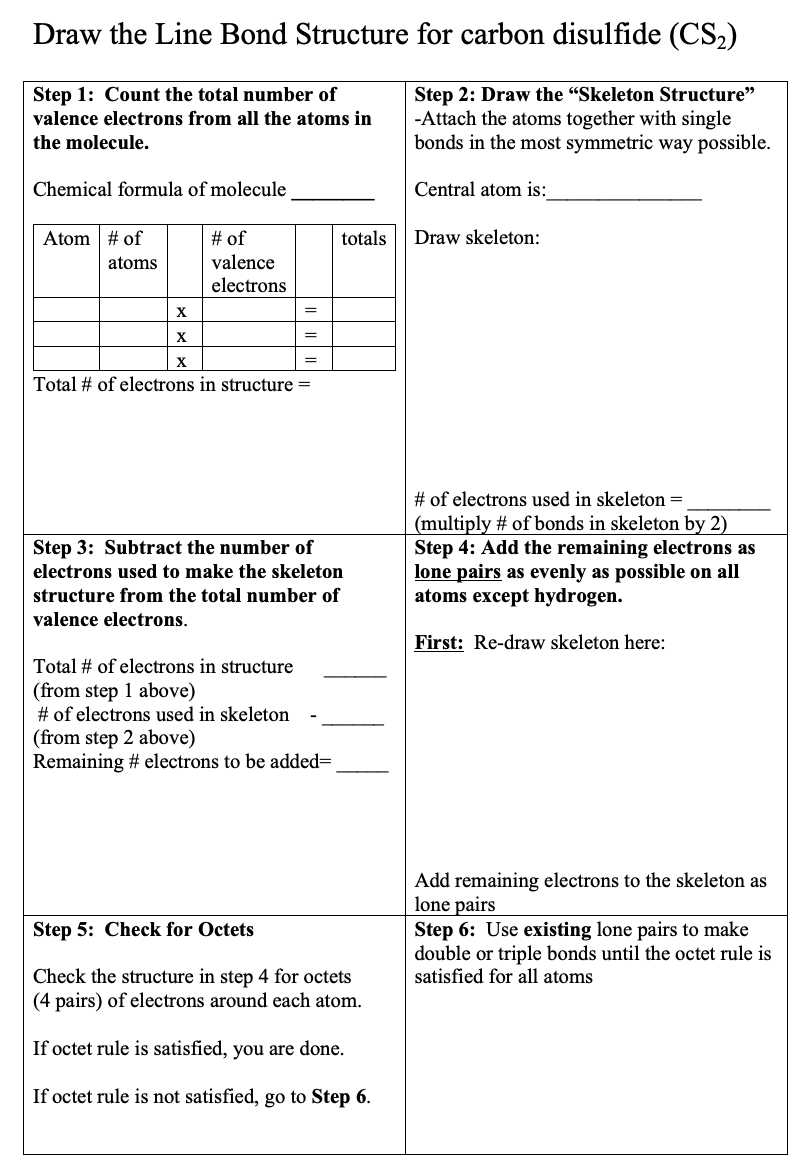Draw the Line Bond Structure for carbon disulfide (CS₂) Step 1: Count the total number of valence electrons from all the atoms in the molecule. Step 2: Draw the "Skeleton Structure" -Attach the atoms together with single bonds in the most symmetric way possible. Central atom is: Chemical formula of molecule Atom # of atoms X X X # of valence electrons = = Total # of electrons in structure = totals Step 3: Subtract the number of electrons used to make the skeleton structure from the total number of valence electrons. Total # of electrons in structure (from step 1 above) # of electrons used in skeleton (from step 2 above) Remaining # electrons to be added= Step 5: Check for Octets Check the structure in step 4 for octets (4 pairs) of electrons around each atom. If octet rule is satisfied, you are done. If octet rule is not satisfied, go to Step 6. Draw skeleton: # of electrons used in skeleton = (multiply # of bonds in skeleton by 2) Step 4: Add the remaining electrons as lone pairs as evenly as possible on all atoms except hydrogen. First: Re-draw skeleton here: Add remaining electrons to the skeleton as lone pairs Step 6: Use existing lone pairs to make double or triple bonds until the octet rule is satisfied for all atoms
Types of Chemical Bonds
The attractive force which has the ability of holding various constituent elements like atoms, ions, molecules, etc. together in different chemical species is termed as a chemical bond. Chemical compounds are dependent on the strength of chemical bonds between its constituents. Stronger the chemical bond, more will be the stability in the chemical compounds. Hence, it can be said that bonding defines the stability of chemical compounds.
Polarizability In Organic Chemistry
Polarizability refers to the ability of an atom/molecule to distort the electron cloud of neighboring species towards itself and the process of distortion of electron cloud is known as polarization.
Coordinate Covalent Bonds
A coordinate covalent bond is also known as a dative bond, which is a type of covalent bond. It is formed between two atoms, where the two electrons required to form the bond come from the same atom resulting in a semi-polar bond. The study of coordinate covalent bond or dative bond is important to know about the special type of bonding that leads to different properties. Since covalent compounds are non-polar whereas coordinate bonds results always in polar compounds due to charge separation.
Can you help me on this ques

Step by step
Solved in 3 steps with 3 images









